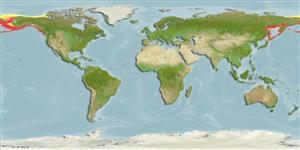Preferred temperature (Ref.
115969): 0.2 - 8, mean 2.2 (based on 653 cells).
Phylogenetic diversity index (Ref.
82804): PD
50 = 0.5000 [Uniqueness, from 0.5 = low to 2.0 = high].
Bayesian length-weight: a=0.00589 (0.00399 - 0.00870), b=3.04 (2.92 - 3.16), in cm Total Length, based on LWR estimates for this species & (Sub)family-body (Ref.
93245).
Trofisk nivå (Ref.
69278): 4.4 ±0.6 se; based on diet studies.
Resiliens (Ref.
120179): Låg, lägsta populationsfördubblingstid 4,5-14 år (tm=3-5).
Prior r = 0.24, 95% CL = 0.16 - 0.36, Based on 1 data-limited stock assessment.
Fishing Vulnerability (Ref.
59153): High to very high vulnerability (70 of 100).
